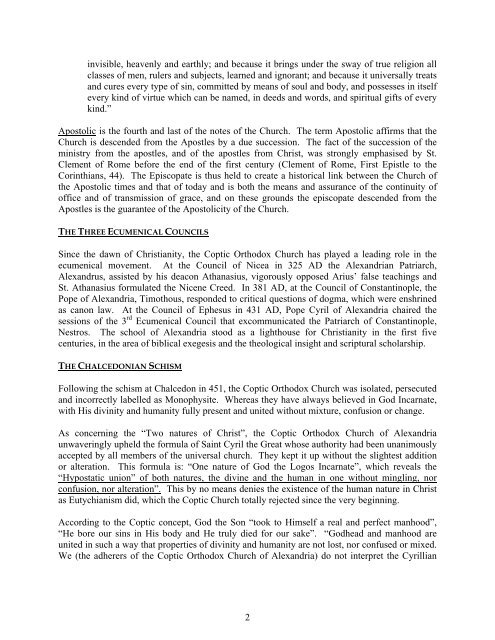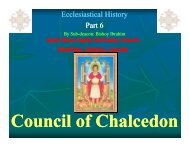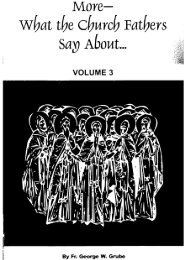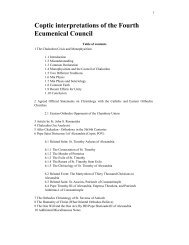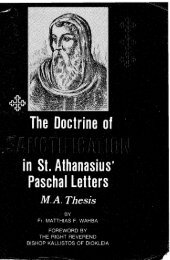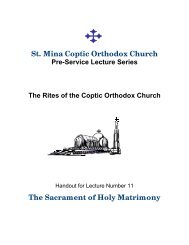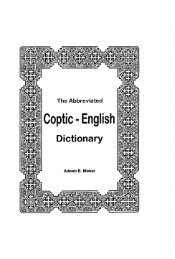Coptic Church & Ecumenical Movement - Saint Mina Coptic ...
Coptic Church & Ecumenical Movement - Saint Mina Coptic ...
Coptic Church & Ecumenical Movement - Saint Mina Coptic ...
Create successful ePaper yourself
Turn your PDF publications into a flip-book with our unique Google optimized e-Paper software.
invisible, heavenly and earthly; and because it brings under the sway of true religion all<br />
classes of men, rulers and subjects, learned and ignorant; and because it universally treats<br />
and cures every type of sin, committed by means of soul and body, and possesses in itself<br />
every kind of virtue which can be named, in deeds and words, and spiritual gifts of every<br />
kind.”<br />
Apostolic is the fourth and last of the notes of the <strong>Church</strong>. The term Apostolic affirms that the<br />
<strong>Church</strong> is descended from the Apostles by a due succession. The fact of the succession of the<br />
ministry from the apostles, and of the apostles from Christ, was strongly emphasised by St.<br />
Clement of Rome before the end of the first century (Clement of Rome, First Epistle to the<br />
Corinthians, 44). The Episcopate is thus held to create a historical link between the <strong>Church</strong> of<br />
the Apostolic times and that of today and is both the means and assurance of the continuity of<br />
office and of transmission of grace, and on these grounds the episcopate descended from the<br />
Apostles is the guarantee of the Apostolicity of the <strong>Church</strong>.<br />
THE THREE ECUMENICAL COUNCILS<br />
Since the dawn of Christianity, the <strong>Coptic</strong> Orthodox <strong>Church</strong> has played a leading role in the<br />
ecumenical movement. At the Council of Nicea in 325 AD the Alexandrian Patriarch,<br />
Alexandrus, assisted by his deacon Athanasius, vigorously opposed Arius’ false teachings and<br />
St. Athanasius formulated the Nicene Creed. In 381 AD, at the Council of Constantinople, the<br />
Pope of Alexandria, Timothous, responded to critical questions of dogma, which were enshrined<br />
as canon law. At the Council of Ephesus in 431 AD, Pope Cyril of Alexandria chaired the<br />
sessions of the 3 rd <strong>Ecumenical</strong> Council that excommunicated the Patriarch of Constantinople,<br />
Nestros. The school of Alexandria stood as a lighthouse for Christianity in the first five<br />
centuries, in the area of biblical exegesis and the theological insight and scriptural scholarship.<br />
THE CHALCEDONIAN SCHISM<br />
Following the schism at Chalcedon in 451, the <strong>Coptic</strong> Orthodox <strong>Church</strong> was isolated, persecuted<br />
and incorrectly labelled as Monophysite. Whereas they have always believed in God Incarnate,<br />
with His divinity and humanity fully present and united without mixture, confusion or change.<br />
As concerning the “Two natures of Christ”, the <strong>Coptic</strong> Orthodox <strong>Church</strong> of Alexandria<br />
unwaveringly upheld the formula of <strong>Saint</strong> Cyril the Great whose authority had been unanimously<br />
accepted by all members of the universal church. They kept it up without the slightest addition<br />
or alteration. This formula is: “One nature of God the Logos Incarnate”, which reveals the<br />
“Hypostatic union” of both natures, the divine and the human in one without mingling, nor<br />
confusion, nor alteration”. This by no means denies the existence of the human nature in Christ<br />
as Eutychianism did, which the <strong>Coptic</strong> <strong>Church</strong> totally rejected since the very beginning.<br />
According to the <strong>Coptic</strong> concept, God the Son “took to Himself a real and perfect manhood”,<br />
“He bore our sins in His body and He truly died for our sake”. “Godhead and manhood are<br />
united in such a way that properties of divinity and humanity are not lost, nor confused or mixed.<br />
We (the adherers of the <strong>Coptic</strong> Orthodox <strong>Church</strong> of Alexandria) do not interpret the Cyrillian<br />
2


